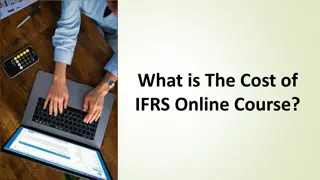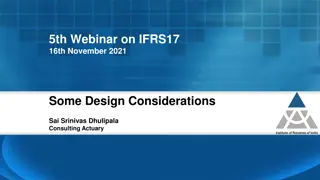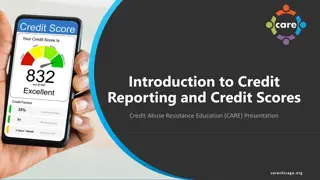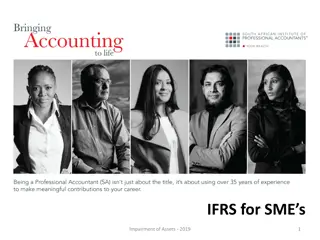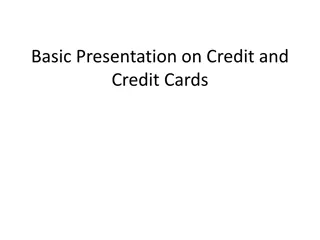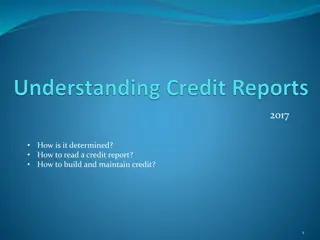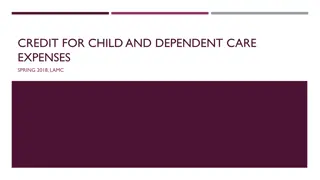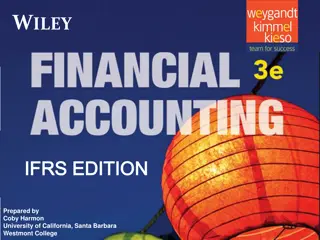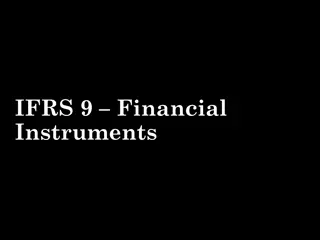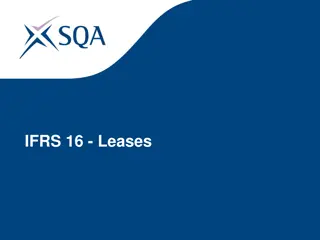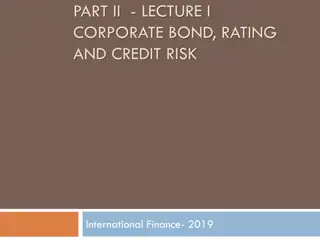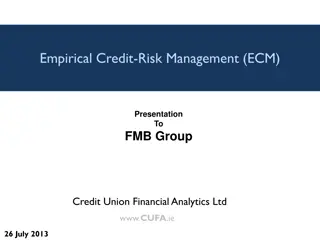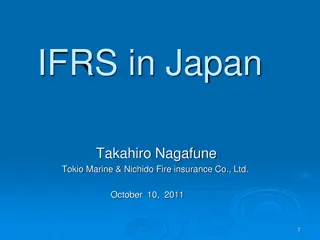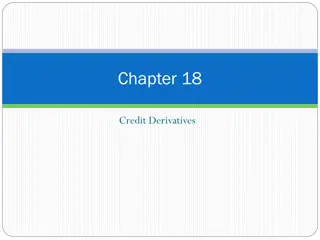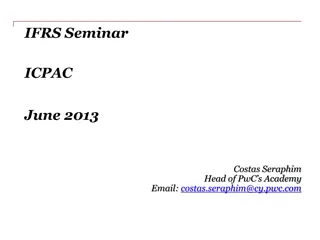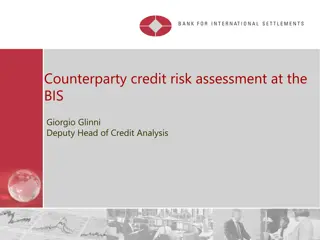Understanding IFRS 9 Significant Increase in Credit Risk
Explore the principles and indicators of Significant Increase in Credit Risk (SICR) under IFRS 9, including assessment methods, change in risk of default, and timing considerations. Learn about lifetime expected credit losses, rebuttable presumptions, and common indicators of credit risk escalation in financial instruments.
Download Presentation

Please find below an Image/Link to download the presentation.
The content on the website is provided AS IS for your information and personal use only. It may not be sold, licensed, or shared on other websites without obtaining consent from the author. Download presentation by click this link. If you encounter any issues during the download, it is possible that the publisher has removed the file from their server.
E N D
Presentation Transcript
IFRS 9 SIGNIFICANT INCREASE IN CREDIT RISK NAS VIRTUAL INDUSTRY CONFERENCE 30 JUNE 2021 SAMUEL DIWOUTA MBENGUE
AGENDA SECTIONS PRINCIPLES OF SICR IFRS 9 AND SICR COMMON INDICATORS OF SICR WHAT IS SIGNIFICANT? SICR EFFICACY TRANSFER RATIO ANALYSIS TRIGGERED RATES ROLL RATES RANK ORDERING FALSE POSITIVES AND FALSE NEGATIVES ERROR TRADE-OFF 2 IFRS 9 SIGNIFICANT INCREASE IN CREDIT RISK
PRINCIPLES OF SICR ASSESSMENT OF SIGNIFICANT DETERIORATION 3 IFRS 9 SIGNIFICANT INCREASE IN CREDIT RISK
IFRS 9 AND SICR CHANGE IN RISK OF DEFAULT 5.5.3 At each reporting date, an entity shall measure the loss allowance for a financial instrument at an amount equal to the lifetime expected credit losses if the credit risk on that financial instrument has increased significantly since initial recognition Significant increase in credit risk? STAGE 1 12-MONTH ECL STAGE 2 LIFETIME ECL 5.5.9 When making the assessment, an entity shall use the change in the risk of a default occurring over the expected life of the financial instrument instead of the change in the amount of expected credit losses Risk of default at origination Risk of default at reporting date COMPARE ORIGINATION DATE REPORTING DATE 4 IFRS 9 SIGNIFICANT INCREASE IN CREDIT RISK
IFRS 9 AND SICR TIMING OF SIGNIFICANT INCREASE IN CREDIT RISK 30 DAYS PAST DUE REBUTTABLE PRESUMPTION 5.5.11 Regardless of the way in which an entity assesses significant increases in credit risk, there is a rebuttable presumption that the credit risk on a financial asset has increased significantly since initial recognition when contractual payments are more than 30 days past due B5.5.2 Lifetime expected credit losses are generally expected to be recognised before a financial instrument becomes past due. Typically, credit risk increases significantly before a financial instrument becomes past due or other lagging borrower-specific factors (for example, a modification or restructuring) are observed B5.5.7 The assessment of whether lifetime expected credit losses should be recognised is based on significant increases in the likelihood or risk of a default occurring since initial recognition instead of on evidence of a financial asset being credit-impaired at the reporting date or an actual default occurring. Generally, there will be a significant increase in credit risk before a financial asset becomes credit-impaired or an actual default occurs. B5.5.19 The rebuttable presumption is not an absolute indicator that lifetime expected credit losses should be recognised, but is presumed to be the latest point at which lifetime expected credit losses should be recognised even when using forward-looking information. 5 IFRS 9 SIGNIFICANT INCREASE IN CREDIT RISK
COMMON INDICATORS OF SICR FORWARD-LOOKING INFORMATION INDICATORS 5.5.11 If reasonable and supportable forward-looking information is available without undue cost or effort, an entity cannot rely solely on past due information when determining whether credit risk has increased significantly since initial recognition LAGGING FORWARD-LOOKING 30+ days past due QUALITATIVE QUANTITATIVE B5.5.2 when reasonable and supportable information that is more forward-looking than past due information is available without undue cost or effort, it must be used to assess changes in credit risk. Modification /Restructure Lifetime PD increase Watch list Contagion Internal credit scores Credit bureau info External credit ratings Partial arrears Breach of covenant 6 IFRS 9 SIGNIFICANT INCREASE IN CREDIT RISK
WHAT IS SIGNIFICANT? IFRS 9 Standard is not precise about the definition of significance Significance is subjective. It depends on: Risk appetite Nature of counterparties Nature of instrument DAYS IN EXCESS Revolving facility CONTAGION Retail portfolio ORM HIGH RISK WATCH LIST Non-retail portfolio Default rates Default rates Default rates Time Time Time (14,30) dpd (7,30) dpd 0 dpd 30+ dpd No Yes No Yes 7 IFRS 9 SIGNIFICANT INCREASE IN CREDIT RISK
SICR EFFICACY The assessment determines whether exposures receive a 12-month or lifetime impairment Integral and critical element of IFRS 9 Tool for determination of forward-looking provisioning Impairment and disclosure implications CYCLICALITY ADEQUACY Moving the correct quantity of accounts to stage 2 RANK ORDERING Transfer ratio analysis ADEQUACY RANK ORDERING Moving the right accounts to stage 2 False positives and negatives CYCLICALITY Responsiveness to changing macroeconomic factors Transfer ratio analysis 8 IFRS 9 SIGNIFICANT INCREASE IN CREDIT RISK
TRANSFER RATIO ANALYSIS ADEQUACY OF TRIGGERED POPULATION 9 IFRS 9 SIGNIFICANT INCREASE IN CREDIT RISK
TRANSFER RATIO ANALYSIS The purpose of the transfer ratio analysis is to assess the whether a SICR assessment is moving an adequate quantity of exposures to stage 2. It assesses the adequacy of the stringency of SICR thresholds and determines whether the triggered population is in line with historical rolls of performing exposures into arrears and default. Top-down assessment Synonymous to backtest for SICR assessment Can be used to fine tune SICR thresholds Does not assess rank ordering 1 0 IFRS 9 SIGNIFICANT INCREASE IN CREDIT RISK
TRIGGERED RATES % ???? ????????? =?????????? ?????????? ?????????? ?? ????? 2 ?? ??????????? ???? ?????????? ?????????? ?? ??????????? ???? AT-RISK POPULATION (DENOMINATOR) Population at risk of being flagged as SICR d and moved to stage 2 SICR triggered rates Excludes: arrears, defaults and distressed restructures 12% 10% TRIGGERED POPULATION (NUMERATOR) 8% Performing population classified as stage 2 due to the SICR assessment Forward-looking triggers only 6% 4% OTHER CONSIDERATIONS 2% Weightings: volume and exposure Assessment period: medium to long term 0% Time Frequency of snapshots: monthly or quarterly 11 IFRS 9 SIGNIFICANT INCREASE IN CREDIT RISK
ROLL RATES ???? ????? =?????????? ?????????? ???????????? ???? ????????????? ???? ??????????? ?????? ?????????? ?????????? ?? ????? ?? ??????????? ?????? AT-RISK POPULATION (DENOMINATOR) Population at risk of being flagged as SICR d and moved to stage 2 Roll rates 10% Excludes: arrears, defaults and distressed restructures 8% TRUE AND SIGNIFICANT DETERIORATION (NUMERATOR) 6% Irrefutable SICR point: 30 days past due, default or distressed restructure Exclusion of technical arrears 4% Exact timing of deterioration ignored 2% Multiple deterioration treated as single deterioration 0% Time OTHER CONSIDERATIONS If exposure weighted, use exposure at period start of cohort 12M arrears 12M default rate Recommended observation period: 12 months 12 IFRS 9 SIGNIFICANT INCREASE IN CREDIT RISK
COMPARISON OF TRIGGERED AND ROLL RATES Roll rates vs triggered rates Lag between triggered rates and roll rates Assess trends and cyclicality of roll rates Assess gap between roll rates and triggered rates WHAT IF THE SICR ASSESSMENT CONSISTS OF ONLY THE BACKSTOP? Time 12M roll rates 12M default rates SICR triggered rates 13 IFRS 9 SIGNIFICANT INCREASE IN CREDIT RISK
INTERPRETATION OF RESULTS Scenario 1 Scenario 2 Time Time % Triggered Actual deterioration % Triggered Actual deterioration SICR population adequate, potentially conservative Triggered rates consistently below roll rates Exercise judgment in assessment Possible reasons: Missing triggers SICR thresholds too high 14 IFRS 9 SIGNIFICANT INCREASE IN CREDIT RISK
RANK ORDERING FALSE POSITIVES AND FALSE NEGATIVES 15 IFRS 9 SIGNIFICANT INCREASE IN CREDIT RISK
FALSE POSITIVES AND FALSE NEGATIVES The purpose of this test is to assess the rank ordering ability (or discriminatory power) of SICR assessment Assesses ability to differentiate between goods and bads Poor rank ordering can result in ECL misstatement Rank ordering of assessment is a function of rank ordering ability of SICR indicators and thresholds Examples SICR triggered? Type II error (FN) Type I error (FP) YES NO False alarm False negative (FN) Type II error A guilty person is acquitted True positive (TP) TRUE True deterioration? False positive (FP) Type I error True negative (TN) FALSE High Type I error = assessment triggering too many goods High Type II error = assessment not triggering a lot of bads 16 IFRS 9 SIGNIFICANT INCREASE IN CREDIT RISK
ERROR TRADE-OFF SICR triggered Not triggered Distribution of exposures which did not deteriorate Distribution of exposures which deteriorated True No deterioration deterioration 17 IFRS 9 SIGNIFICANT INCREASE IN CREDIT RISK
CALCULATIONS RANK ORDERING MEASURES False positive rates False negative rates ??% = ????????? & ???????????? ???????????? ??% = ??? ????????? & ???????????? ???????????? CONSIDERATIONS Discriminatory power of PD model ?? ?? = = ?? + ?? ?? + ?? Assess rank ordering over time ??% = ????????? & ??? ???????????? ??? ???????????? ??% = ??? ????????? & ??? ???????????? ??? ???????????? Interpretation of false positives ?? ?? ERROR QUANTIFICATION Staging disclosures = = ?? + ?? ?? + ?? Stage misclassification of exposures ECL impact ??% + ??% = 100% ??% + ??% = 100% Differential between 12-month and lifetime ECLs If false positive, impact is an ECL overstatement If false negative, impact is an ECL understatement 18 IFRS 9 SIGNIFICANT INCREASE IN CREDIT RISK


